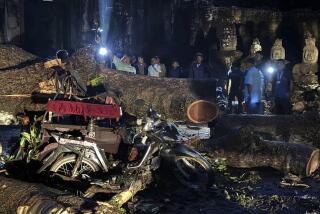Drought and flooding led to collapse of Angkor
A prolonged drought punctuated by intense monsoons that partially destroyed the city’s water-preservation infrastructure led to the 15th century collapse of the ancient city of Angkor, capital of the Khmer Empire, U.S. and Asian researchers reported.
Researchers had suspected that water scarcity played a role in the city’s demise, and the first tree-ring chronology in Asia provides strong support for that speculation. It shows that the drought persisted for decades, which would have severely strained the city’s ability to survive.
Monsoons then inundated Angkor’s extensive canal system with mud and other debris -- which other researchers had previously discovered -- impairing its ability to provide adequate water for the nearly 1 million residents sprawled over an area similar to that of modern-day Los Angeles, the team reported this week in the journal Proceedings of the National Academy of Sciences.
“I think that is the exact scenario” for the city’s collapse, said archaeologist Michael D. Coe, an emeritus professor at Yale University who was not involved in the research.
“The evidence is pretty watertight. . . . The drought interspersed with flood periods was sort of a double whammy” that the city could not survive.
Other factors also played a role, he said. Maritime trading was becoming more important in the region and Angkor was too far inland to benefit; the capital eventually moved to Phnom Phen, near the coast. And the Siamese people were pushing down from the north and northwest, taking over large sections of the Khmer Empire -- based in what is now Cambodia.
Combined with the weather, Coe said, these were “hammer blows that [the city] couldn’t recover from.”
The new chronology is based on tree-ring dating, pioneered in the American Southwest, which provides a highly accurate way to trace climate for hundreds of years. Trees produce a new growth ring under their bark every year. In wet years, the rings are bigger; in dry ones, they are smaller. The distinctive pattern of the rings allows comparisons among trees and provides accurate dates for historical events.
In this study, dendrochronologist Brendan M. Buckley of Columbia University’s Lamont-Doherty Earth Observatory and his colleagues used cores obtained from a species of cypress called Fokienia hodginsii. The long-lived trees were studied in Vietnam’s Bidoup Nui Ba National Park, which is near enough to Cambodia to share the same climate.
The National Science Foundation, which sponsored the research, noted that the trees are an endangered species because they are being widely harvested for the illicit timber trade.
The team compiled a chronology from AD 1250 to 2008. They found that the mid- to late 1300s experienced persistently dry conditions that were followed by several years of unusually strong monsoons that may have damaged the city’s infrastructure. A shorter but more severe drought in the early 1400s may then have provided the city’s death knell.
Most historians date the fall of the city to 1431, when the Siamese army captured it. It was overgrown by jungle and not seen again until it was rediscovered by French anthropologists in the 1860s.
But it has been only over the last dozen years that radar images from space have shown the extent of the city and the sophisticated canal systems that supported it. Ground studies have shown that many of the canals were filled with debris from flash floods, and now researchers have a much better idea of when and why that happened.
thomas.maugh@
latimes.com








